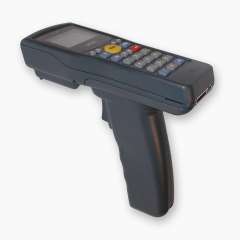
- Light and ergonomic
- Barcode Scanner 1D/2D
- Real Time Clock
- Li-Ion removable Battery
How can I configure the transponder types to be read on the AT-120?
Use the AT-120 utility. The AT-120 instruction manual contains the appropriate description.
How can I read transponder tags with a LogiScan-600/800/1100 without special application?
How can I set the transponder types to be read in the LogiScan-600/800/1100 in the RFID module?
When a LogiScan-600/800/1100 with RFID module is delivered, all transponder types are normally activated. If the transponder types in the RFID module are set by the application, a manual setting is not possible or will be overwritten by the next start of the application. If the transponder types are not set by the application, a manual configuration can be made as follows:
We want to introduce RFID technology in our company. For which operating frequency (125/134 kHz, 13.56 MHz or 868 MHz) should we choose?
The operating frequencies 125/134 kHz and 13.56 MHz are suitable for applications with low reading distances. If the transponder is only to be used for identification, a read-only transponder suffices. If data is to be stored in the transponder, a read-write transponder is necessary. The 125/134 kHz technique (LF) still distinguishes between read-only (read-only) and read-write transponders (chip has an additional data memory). This is historically, since the RFID development started with LF technology and these read-only chips were cheaper. At all other operating frequencies, there are now mostly read / write transponders.
The 125 kHz technique allows mobile devices to read distances up to 10 cm (depending on antenna and tag size.) Even if the transponder tags are attached to metal or embedded in it, automatic identification is possible Are, among other things, production control, object/goods identification in the metal environment, access control and animal identification.
13.56 MHz transponders enable the simultaneous reading of several transponders with their anti-collision technology. The range with mobile devices is however shorter than at 125/134 kHz and is max. Few centimeters. Areas of application are, inter alia, Production control, object/goods identification, access control, ticketing (e.g. public transport, events).
868-MHz tags (UHF) offer a high reading range of up to 10 meters, but the carrier material on which the tags are attached, as well as the contents of the packaging, have a great influence on the range. Areas of application are, inter alia, Production control with read distances greater than 2 meters, logistics, material flow (pallets etc.), object/goods identification (reusable and transport packaging).